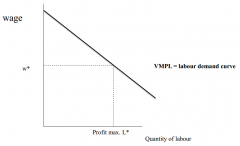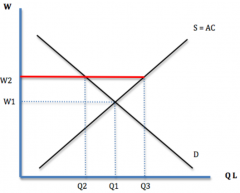![]()
![]()
![]()
Use LEFT and RIGHT arrow keys to navigate between flashcards;
Use UP and DOWN arrow keys to flip the card;
H to show hint;
A reads text to speech;
19 Cards in this Set
- Front
- Back
|
Demand for labour is...
|
A derived demand from the production of a good or service.
|
|
|
Firms hire workers until
or Firms maximise profits when |
Value of Marginal Product of Labour= The market wage.
VMPL = w* - If VMPL < w*, the firm loses money on the last worker - If VMPL > w*, the firm can hire more labour and increase output |
|
|
Key: the VMPL diminishes (is downward sloping) as more workers are added to the production process.
|

|
|
|
What shifts the labour demand curve?
|
- Change in demand for a product
- Change in labour productivity - Change in cost of employment; i.e. wages |
|
|
Basic labour market theory:
|
Supply and demand for different types of labour determine the wages.
|
|
|
Determinants of equilibrium wages
|
1. Compensating differentials
2. Human capital theory (knowledge/ability/social) 3. Ability, effort and chance 4. Signalling 5. Superstar phenomenon 6. Unions (market power) 7. Efficiency wages 8. Discrimination |
|
|
Compensating differential
|
Difference in wages that arises from non-monetary
characteristics of different jobs |
|
|
Human capital:
|
Represents the accumulation of investments in people.
|
|
|
Why does education lead to higher wages?
|
Educated workers have a higher VMPL (i.e. they are
more productive), so firms are happy to pay them a higher wage. |
|
|
Human capital view of education:
|
Schooling makes workers more productive, and therefore they earn higher wages.
|
|
|
Alternative view of education:
|
Firms use education as a way to differentiate between high-ability and low-ability workers.
eg. Uni is a signal of high ability to employers |
|
|
A Union creating unemployment
|

If unions push up wages to W2, the supply of labour (Q3) is greater than the demand for labour (Q2) this creates unemployment.
|
|
|
Benefits of a Union
|
- Improve working conditions
- Antidote to market power, e.g. to balance a power of a monopoly |
|
|
Union negotiations are difficult because:
|
higher wages = transfer from company’s shareholders to employees.
|
|
|
Labour force =
|
number of employed + number of unemployed
|
|
|
Unemployment rate =
|
(Number of unemployed/ labour force) x 100
|
|
|
Costs of unemployment
|
• Economic costs:
– Lost wages and production – Decreased taxes and increased transfers • Psychological costs: – Individual self-esteem, adverse effects on health • Social costs: – Potential increases in crimes and social problems – Resources spent to address these |
|
|
Frictional unemployment
|
It takes time for workers to search for and find jobs in
new sectors. (Usually short-term) |
|
|
Structural unemployment
|
Unemployment resulting from industrial reorganization, typically due to technological change, rather than fluctuations in supply or demand.
|

